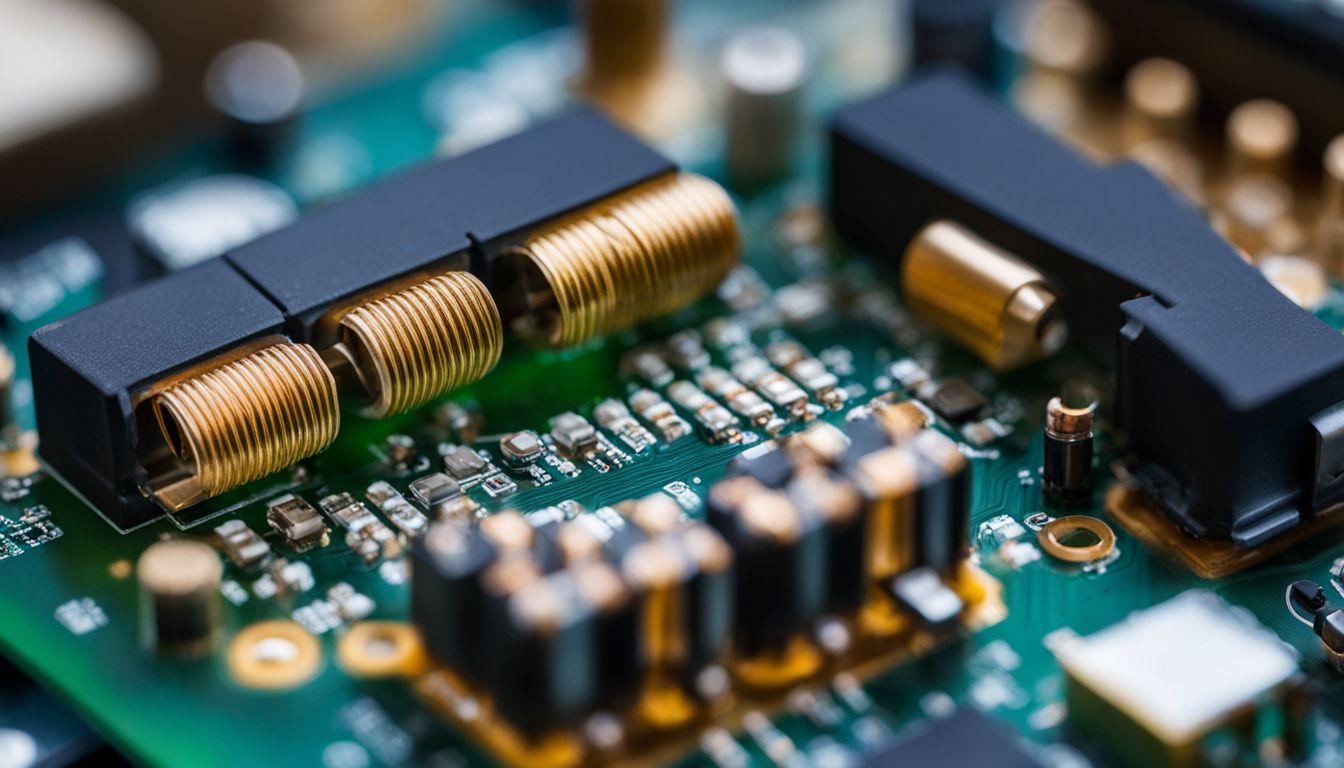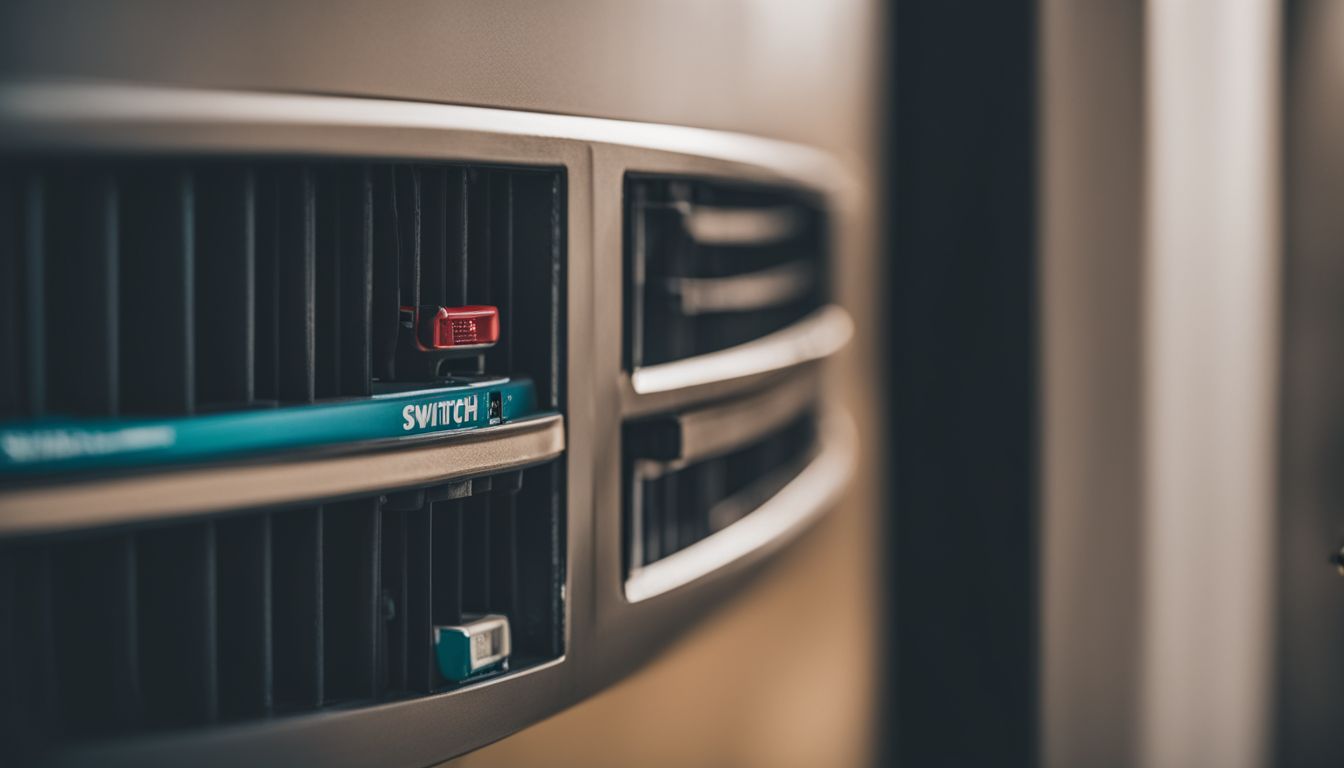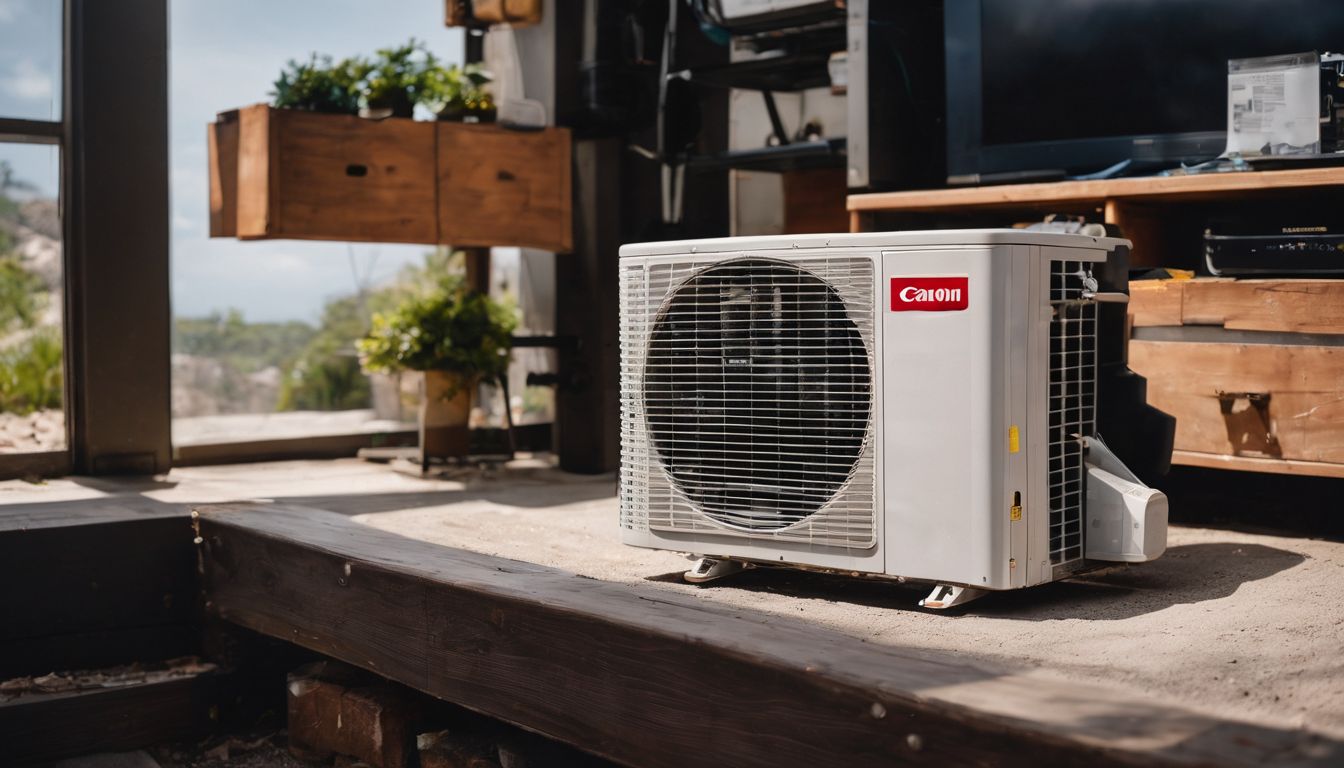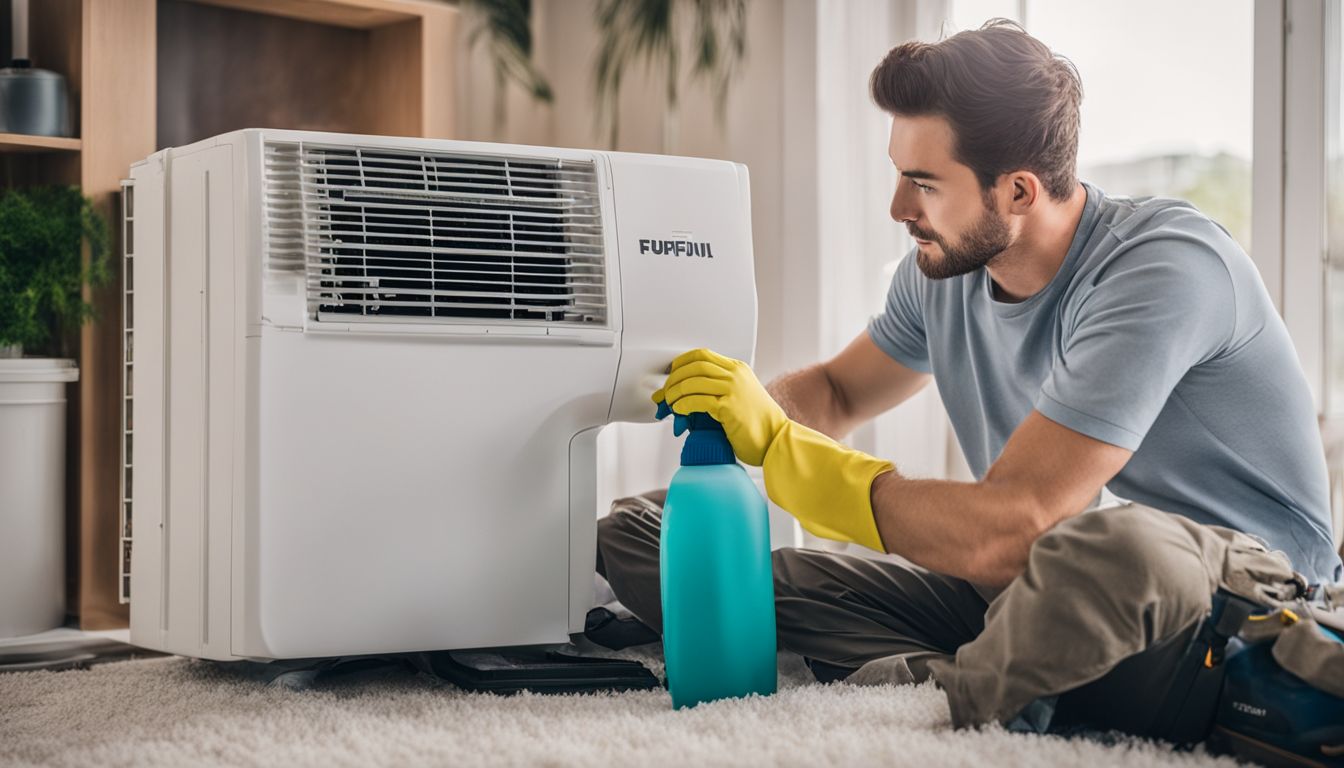Many of us find ourselves grappling with a fickle air conditioner, unsure why it won’t cool our rooms efficiently. Did you know that an aircon is much like a complex puzzle, made up of various crucial pieces working in tandem? This article will delve into each significant part of your air conditioning unit to help you understand its operation and how to keep it running smoothly.
Stay tuned for insights that could save you both discomfort and money.
Dispelling Common Myths and Misconceptions about Air Conditioning
Air conditioners have evolved significantly since their inception, but myths about their energy consumption persist. Modern air conditioning systems are designed with efficiency in mind, and while they do use electricity, advancements in technology mean that they don’t guzzle power as some might believe.
Servicing your unit is critical—think of it like car maintenance—to keep it running smoothly and to prevent inefficient operation which can lead to higher energy bills.
Another misconception is the idea that leaving an air conditioner on all day saves more energy than cycling it on and off. This isn’t true; air conditioners work best when they maintain a consistent temperature.
It’s also a mistake to think that cranking down the thermostat setting will cool a room faster; ACs cool at a standard rate regardless of the temperature setting. A larger aircon doesn’t always equate to effective cooling—in fact, proper sizing relative to the space being cooled is key for optimum performance.
Furthermore, where you place your thermostat plays an important role in how effectively your system can regulate indoor climate control.
Regular servicing does much more than just maintain parts; it ensures the entire system functions efficiently and safely, safeguarding against costly repairs or replacements down the line.
Forget any notion that this process is merely an unnecessary expense—it’s an investment into extending your unit’s life span and maintaining high indoor air quality for everyone enjoying the cool comfort of your home or office.
Basics of Air Conditioning
An air conditioning system works on the principle of heat transfer, using refrigeration cycle technology to move heat from inside a space to the outside. The system relies on a working fluid called refrigerant which absorbs and releases heat as it circulates through various components of an AC unit.
This process not only cools down the air but also removes excess moisture, making indoor environments more comfortable.
Central air-conditioning systems have become crucial in managing indoor climates for homes and businesses alike. They consist of an interconnected network that includes evaporator coils where the cold refrigerant passes, absorbing heat and water vapour from indoor air.
The warm refrigerant then travels to the outdoor unit where condenser coils release absorbed heat into the outside environment, thus cooling down again before re-entering your home or office space.
With advancements like smart thermostats and energy-efficient designs, these systems effectively control temperature while keeping operational costs low.
Key Components of an Air Conditioner
Understanding the key components of an air conditioner is essential for anyone looking to grasp how this sophisticated machine efficiently maintains our comfort levels through the precise manipulation of air and temperature; continue reading to unveil the intricate workings beneath its cool facade.
Evaporator Coil
The evaporator coil plays a crucial role in your air conditioner’s ability to deliver cool air inside your home. Located within the indoor unit, this component acts like a sponge, absorbing heat from the surrounding air as it passes over its extremely cold surface.
This process occurs due to the refrigerant that circulates through the coils, which evaporates and captures heat efficiently.
Regular checks and maintenance of the evaporator coil are vital for smooth operation. Dirt build-up can inhibit its capacity for heat absorption, leading to inefficiency and higher energy costs.
Ensuring it stays clean helps maintain optimum heat exchange during the cooling cycle, keeping your environment comfortable while promoting energy efficiency in your HVAC system.
Expansion Valve
An expansion valve stands as a crucial gatekeeper in an air conditioner, controlling the flow of refrigerant. This small but mighty component adjusts the rate at which refrigerant enters the evaporator coil.
It ensures that just the right amount of liquid turns into gas, keeping your space cool and comfortable.
This valve also helps maintain optimal pressure throughout the cooling cycle by managing how much coolant is released from high-pressure to low-pressure zones. A properly functioning expansion valve can be key to efficient energy use, potentially saving money on power bills over time.
Its ability to handle various pressures and temperatures makes it essential for consistent performance in different climates and settings.
Refrigerant
Refrigerant plays a crucial role in air conditioners and heat pumps, acting as the lifeblood of the system. It’s this special fluid that travels through the entire unit to shift temperatures—from inside your home to outside.
Starting as a low-pressure gas, it quickly absorbs indoor heat. As it moves, it transforms into a high-pressure liquid.
This process is part of what’s known as the vapour-compression cycle—a key concept in how HVAC systems function efficiently. The refrigerant makes its way through coils and piping, picking up warmth from your living space and releasing it outdoors.
Without this substance’s unique ability to change physical states while controlling temperature changes effectively, modern air conditioning would be impossible.
Compressor
At the heart of your air conditioner’s refrigeration cycle, the compressor plays a critical role. It takes low-pressure vapour and transforms it into high-pressure vapour. This process is essential for heat exchange to occur in the system’s condenser and evaporator coils.
Acting like a large electric pump, the compressor moves refrigerant through the air conditioning system.
Regular maintenance ensures that this vital component operates smoothly. A well-functioning compressor enables efficient cooling by effectively increasing both the pressure and temperature of the vapour refrigerant.
Without it, your AC unit cannot circulate refrigerant or maintain cool temperatures inside your home or office. Therefore, keeping an eye on its performance can lead to a longer-lasting air conditioning system with optimal efficiency levels throughout the hot summer months or whenever you need to beat the heat indoors.
Condenser Coil
The condenser coil plays a pivotal role in your air conditioner, transforming hot refrigerant gas into liquid form. This key component not only turns the gas into a cooler state but also releases unwanted heat into the outdoor air, maintaining a comfortable temperature inside your home.
Its efficiency relies heavily on its cleanliness; a dirty condenser coil can lead to reduced cooling and higher energy bills.
Made from materials like copper or aluminium due to their excellent heat transfer properties, the condenser helps manage the flow of heat out of your living spaces. It is crucial to ensure that your cooling system functions properly and sustains an optimal performance level throughout those sweltering summer months.
Regular maintenance of this integral part prevents potential breakdowns and maintains consistent indoor comfort.
The Role of the Thermostat in Air Conditioning
Thermostat sensors are crucial for starting and stopping the air conditioning process. They detect when your room reaches the desired temperature, and then switch off to save energy. If it gets too warm, they kick in and activate the cooling cycle again.
This continuous monitoring maintains a steady, comfortable climate indoors without any fuss.
Acting as both sentinel and regulator, the thermostat keeps your living space just how you like it. It makes real-time decisions that manage temperature effectively. With such control at its helm, an air conditioner operates smoothly and ensures that you enjoy a consistent level of comfort throughout your day or night.
Understanding the Capacitor and PCB
In the intricate dance of air conditioning mechanics, two components often overlooked yet vital to functionality are the capacitor and PCB. The capacitor plays a pivotal role in starting and maintaining the motor’s energy cycle, while the printed circuit board, or PCB, serves as the system’s electronic command centre, orchestrating operations with precision.
The Capacitor

The capacitor plays a vital role in your air conditioner’s functionality. It stores electrical energy like a battery, using two conductive plates separated by an insulating material called a dielectric.
This component is essential because it provides the initial burst of electricity to kick-start the motors that drive the compressor and fans. Without this surge of power, your aircon unit wouldn’t start up or maintain efficiency during operation.
Every AC system relies on its capacitors for stable and consistent energy distribution. Decoupling capacitors helps smooth out fluctuations in the power supply, ensuring that other components such as the printed circuit board (PCB) function without interruptions from electrical noise or surges.
They effectively support distributed energy within the internal circuits, making sure your cooling experience remains uninterrupted even when there’s a sudden demand for more power.
The PCB (Printed Circuit Board)
Printed circuit boards (PCBs) sit at the heart of an air conditioning unit, acting as a crucial interface that directs commands and manages data across the system’s various components.
They ensure capacitors, relays, resistors, and other key parts work together harmoniously to maintain the necessary settings for cooling or heating. A PCB coordinates this dance of electrical elements by providing pathways for power to move precisely where it’s needed.
Problems with a PCB can lead to malfunctions in temperature control or efficiency in your air cooler. As the foundation of electronic interactions within the device, understanding its layout is essential for pinpointing issues — from leakage resistances affecting performance to IR effects compromising component communication.
Expertise in PCB assembly allows maintenance professionals to diagnose faults accurately and carry out effective repairs on intricate air-conditioning units’ circuitry.
The Importance of the Blower Motor and Blower Fan
The blower motor and fan are pivotal in an air conditioning system, propelling cooled air through the ducts into your living spaces. Their efficient operation is essential for maintaining consistent airflow and achieving optimal indoor comfort levels.
Blower Motor
In your air conditioning system, a blower motor plays an essential part. It powers the fan that forces cool air through ducts and into various rooms of your home or building. Imagine it as the heart of the HVAC unit; without it, conditioned air wouldn’t move efficiently throughout the space.
This component features different speeds controlled by settings on your thermostat, adjusting how quickly or slowly you feel that refreshing breeze. A malfunctioning blower motor means weak airflow and poor temperature management, highlighting its crucial role in keeping indoor environments comfortable year-round.
With advancements like variable speed motors, these devices are getting more efficient at managing energy consumption while providing steady climate control where it counts.
Blower Fan
The blower fan plays a vital role in circulating air through the HVAC system and into your home’s living spaces. It uses the power provided by the blower motor to push cooled and conditioned air from the main unit out through ductwork, ensuring that every room reaches a comfortable temperature.
This component is crucial for maintaining consistent airflow, which contributes significantly to the efficiency of your air conditioning system.
Designed to work seamlessly with other parts like evaporator coils and condensers, the blower fan keeps fresh air moving throughout your space. Its operation impacts indoor air quality as it helps distribute filtered air, reducing allergens and pollutants in your environment.
Keeping this part in good working order ensures energy-efficient performance and prolongs the lifespan of your AC system, highlighting its importance within heat-pumping processes that keep homes cool on hot days.
The Air Filter and its Role in Air Conditioning
Air filters play a critical role in air conditioning by trapping and holding various particulates such as dust, pollen, and smoke. These unwanted particles are kept out of the indoor environment, ensuring that the air we breathe stays clean and healthy.
The effectiveness of an air filter is often determined by its collection mechanisms – impacting not just our health but also the overall performance of the HVAC system.
Regular replacement or cleaning of air filters is essential for maintaining optimal functionality. Dirty filters can cause a significant drop in energy efficiency as they force the system to work harder to push air through clogged material.
Furthermore, ignoring filter maintenance could lead to poor indoor air quality and might even contribute to microplastic fibre pollution inside homes and offices. Therefore, ensuring that your heating, cooling, and ventilation systems have clean filters is vital for both human well-being and machine longevity.
Understanding the Aircon Vent and Ductwork
The proper function of an aircon unit hinges on the seamless operation of its vent and ductwork, conduits responsible for delivering cooled air throughout your space. Delve into the intricacies of these systems to gain insight into how they maintain optimal airflow and temperature distribution in modern cooling setups.
Aircon Vent
Aircon vents play a crucial role in the efficiency and effectiveness of your cooling system. They serve as gateways that allow filtered, conditioned air to circulate throughout your space while drawing out warm air to keep your environment comfortable.
Ensuring these vents are unobstructed can make a significant difference in how well an air conditioning unit performs.
Indoor aircon vents specifically focus on filtering incoming air which helps maintain indoor air quality by keeping dust and allergens at bay. Vents that feel excessively cold might indicate low humidity levels within the room, suggesting adjustments must be made for optimal performance.
Regular cleaning is essential to prevent blockages that can strain the system and reduce airflow, critically impacting both energy consumption and comfort levels in any living or working space.
Ductwork
Ductwork plays a central role in an air conditioning system, acting as the transit system that delivers cool or warm air throughout your home. It’s made primarily from folded galvanised steel, which shapes into sturdy passages for airflow – imagine it like a tunnel system beneath a busy city directing traffic exactly where it needs to go.
These metal channels are crucial; without them, the heated or cooled air wouldn’t reach you, no matter how well the rest of your HVAC unit functions.
Properly installed and maintained ducting ensures every room gets its share of temperature-controlled comfort. In any forced-air heating and cooling system, ducts are essential for distributing conditioned air effectively across different zones within a building.
Each section of this network must be sealed and insulated appropriately to prevent energy loss and maintain optimal indoor air quality by avoiding contamination that could spread through poorly fitted joints.
Damper and Drain Pan: Lesser-Known but Essential Parts
While not often highlighted, the damper and drain pan play crucial roles in maintaining the efficiency and proper function of your air conditioning system. The damper regulates airflow within ducts to balance and control temperatures throughout the space, while the drain pan catches condensation to prevent water damage and improve indoor air quality.
Damper
HVAC dampers play a crucial role in the air conditioning system by regulating airflow and directing it to various zones within your home. These components consist of multiple adjustable blades housed inside a frame, which can be altered to control the volume of air passing through.
Damper designs vary significantly, but they all share a common purpose: to manage how much air enters different areas of your space.
Automated systems have largely replaced manual dampers because they allow for more precise control over indoor climate conditions. Inlet vane dampers operate much like small vents; they open up to permit airflow or close off completely, functioning similarly to tiny doors that can seal off a room’s air supply.
Blade dampers are particularly effective at sealing and offer quiet operation, making them an excellent choice for maintaining comfortable environments without adding noise pollution.
Drain Pan
The drain pan in your air conditioner plays a crucial role in maintaining a dry and damage-free home. Nestled within the heart of the system, it captures water that forms when warm air hits the cold evaporator coil and condenses.
This simple tray safeguards against potential water leakage that could ruin ceilings or floors by collecting every drop of condensate.
Regular checks ensure this vital component functions correctly, as blockages can lead to overflows causing extensive harm to both the furnace and surrounding areas. Efficient removal of water from this part is key to an effective air conditioning unit.
Some models even integrate their drain pans into overall operation, enhancing performance through innovative use of condensed moisture.
The Isolator Switch and Refrigerant Leak: Understanding Problems

Within the intricate workings of an air conditioning system, issues like a malfunctioning isolator switch or a refrigerant leak can cause significant disruptions. Understanding these problems is key to maintaining optimal performance and addressing faults that might otherwise compromise your unit’s efficiency and safety.
Isolator Switch
An isolator switch, essential in air conditioning systems, serves as a safeguard for both the equipment and the home. It halts electrical current to allow for safe maintenance without triggering safety switches in your house.
Electricians use this device to ensure there’s no power running through the system during repair or servicing, which makes their job safer.
The importance of an isolator switch extends beyond just safety concerns; it also contributes to the longevity of your air conditioner by enabling secure repairs and upgrades. Found near outdoor units or on property walls adjacent to these units, they disconnect power completely, ensuring no electrical hazards occur while work is being done on your cooling system.
This feature is crucial considering how vital regular maintenance is for optimal aircon performance and energy efficiency.
Common Problems: Refrigerant Leak
Refrigerant leaks can sap your air conditioner’s efficiency and cooling power, creating a significant problem for any system. These leaks often stem from accidental damage to the tubing that contains the refrigerant.
The damage might occur during routine services or unexpected repairs, causing the refrigerant – which is essential in the refrigeration cycle – to escape. Without this critical component, your AC unit struggles to pump heat out of your home effectively.
Regular maintenance plays a pivotal role in preventing these leaks by ensuring all parts are intact and functioning correctly. Neglecting this aspect can lead to deteriorated tubing and connections, eventually causing leaks.
Homeowners must have their systems checked periodically not only to maintain optimal performance but also to avoid potential leakage of substances like R22, which can be harmful if released into the atmosphere.
HVAC technicians use their expertise in PCB design and evaporative cooler maintenance to detect early signs of wear and tear that could precede a leak, safeguarding both your comfort and the environment.
Conclusion
Diving into the complexities of an air conditioner reveals a world of intricate parts and processes. Taking this journey equips you with the knowledge to keep your cooling system running smoothly, ensuring comfort on sweltering days.
Each component, from evaporator coils to expansion valves, plays a vital role in delivering that much-needed cool breeze. Maintain your unit well and reap the benefits of efficient performance and extended equipment life.
With understanding comes empowerment; now you’re ready to tackle aircon challenges head-on, ensuring a cooler tomorrow.
FAQs
1. What does a fan coil unit do in my air conditioning system?
In an aircon, the fan coil unit cools and dehumidifies the room’s air by pumping heat out and circulating fresh, cold air back into the space.
2. How does a split system air conditioner work?
Split system air conditioners have two main parts: the outdoor condenser unit that pumps heat away from your home, and an indoor unit that releases cool air into your rooms.
3. Why is humidity control important in HVAC units?
Controlling humidity with HVAC units ensures that the air isn’t too moist or dry, keeping you comfortable and preventing damage to your home due to excessive dampness or dryness.
4. What is vapour compression in terms of aircon systems?
Vapour compression is how most AC systems move heat flowing from inside to outside your home; this process keeps cool using expansion valves and refrigerants within coils.
5. Can you explain what ‘coefficient of performance’ means for my A.C.?
The coefficient of performance (COP) measures how efficiently your A.C. can pump heat relative to its energy usage; higher COP numbers mean better efficiency for heating or cooling.
6. What part does PCB fabrication play in my split air conditioner?
PCB manufacturing produces electronic circuits which manage power quality, temperature settings, and timings – controlling how effectively your split-air conditioner operates.





